Report on Understanding and Leading Change: Blake Logitech's Analysis
VerifiedAdded on 2023/01/10
|11
|2992
|64
Report
AI Summary
This report, focusing on Blake Logitech, explores the impact of organizational change on operations and strategy, analyzing both internal and external drivers. It delves into leadership decision-making, evaluating barriers to change and their influence. The report examines organizational examples showcasing the effects of change and discusses measures to minimize negative impacts, including the application of Bohner and Arnold's strategic model of change impact analysis. It further evaluates different barriers to change and their influence on leadership decisions, including a force field analysis. The report highlights the importance of effective communication, training, and flexible leadership in navigating organizational transformations. It provides insights into how organizations can adapt and thrive in response to various changes in the business environment.
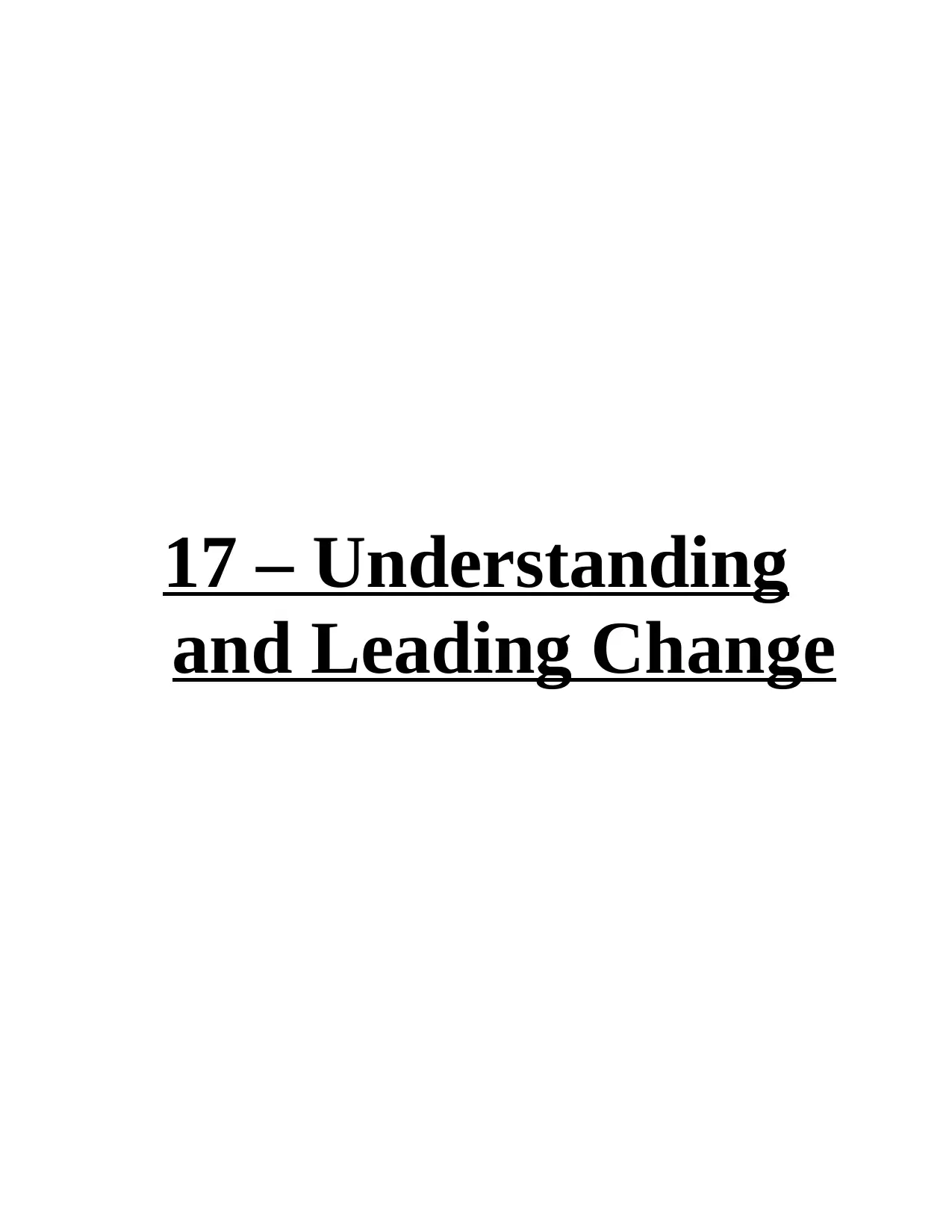
17 – Understanding
and Leading Change
and Leading Change
Paraphrase This Document
Need a fresh take? Get an instant paraphrase of this document with our AI Paraphraser
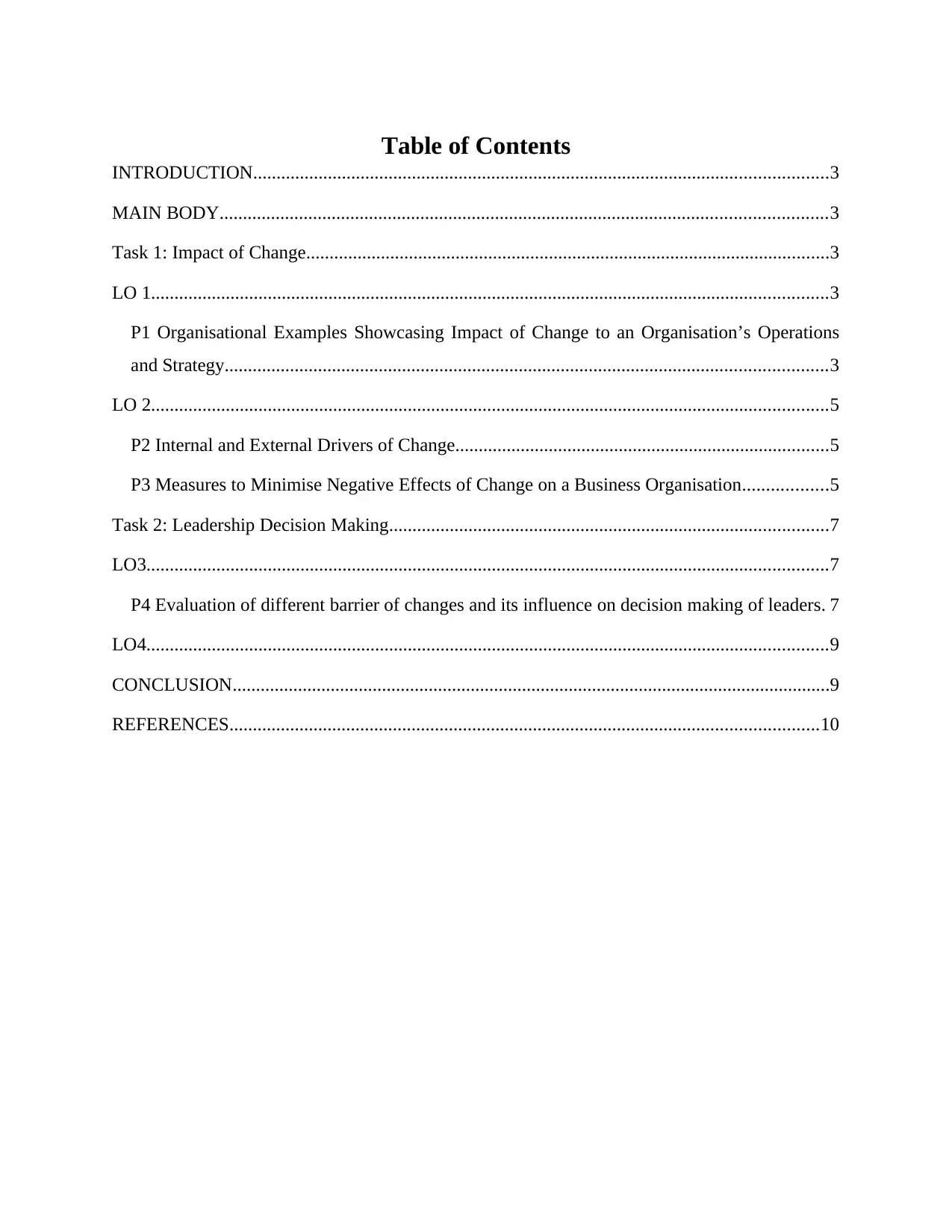
Table of Contents
INTRODUCTION...........................................................................................................................3
MAIN BODY..................................................................................................................................3
Task 1: Impact of Change................................................................................................................3
LO 1.................................................................................................................................................3
P1 Organisational Examples Showcasing Impact of Change to an Organisation’s Operations
and Strategy.................................................................................................................................3
LO 2.................................................................................................................................................5
P2 Internal and External Drivers of Change................................................................................5
P3 Measures to Minimise Negative Effects of Change on a Business Organisation..................5
Task 2: Leadership Decision Making..............................................................................................7
LO3..................................................................................................................................................7
P4 Evaluation of different barrier of changes and its influence on decision making of leaders. 7
LO4..................................................................................................................................................9
CONCLUSION................................................................................................................................9
REFERENCES..............................................................................................................................10
INTRODUCTION...........................................................................................................................3
MAIN BODY..................................................................................................................................3
Task 1: Impact of Change................................................................................................................3
LO 1.................................................................................................................................................3
P1 Organisational Examples Showcasing Impact of Change to an Organisation’s Operations
and Strategy.................................................................................................................................3
LO 2.................................................................................................................................................5
P2 Internal and External Drivers of Change................................................................................5
P3 Measures to Minimise Negative Effects of Change on a Business Organisation..................5
Task 2: Leadership Decision Making..............................................................................................7
LO3..................................................................................................................................................7
P4 Evaluation of different barrier of changes and its influence on decision making of leaders. 7
LO4..................................................................................................................................................9
CONCLUSION................................................................................................................................9
REFERENCES..............................................................................................................................10
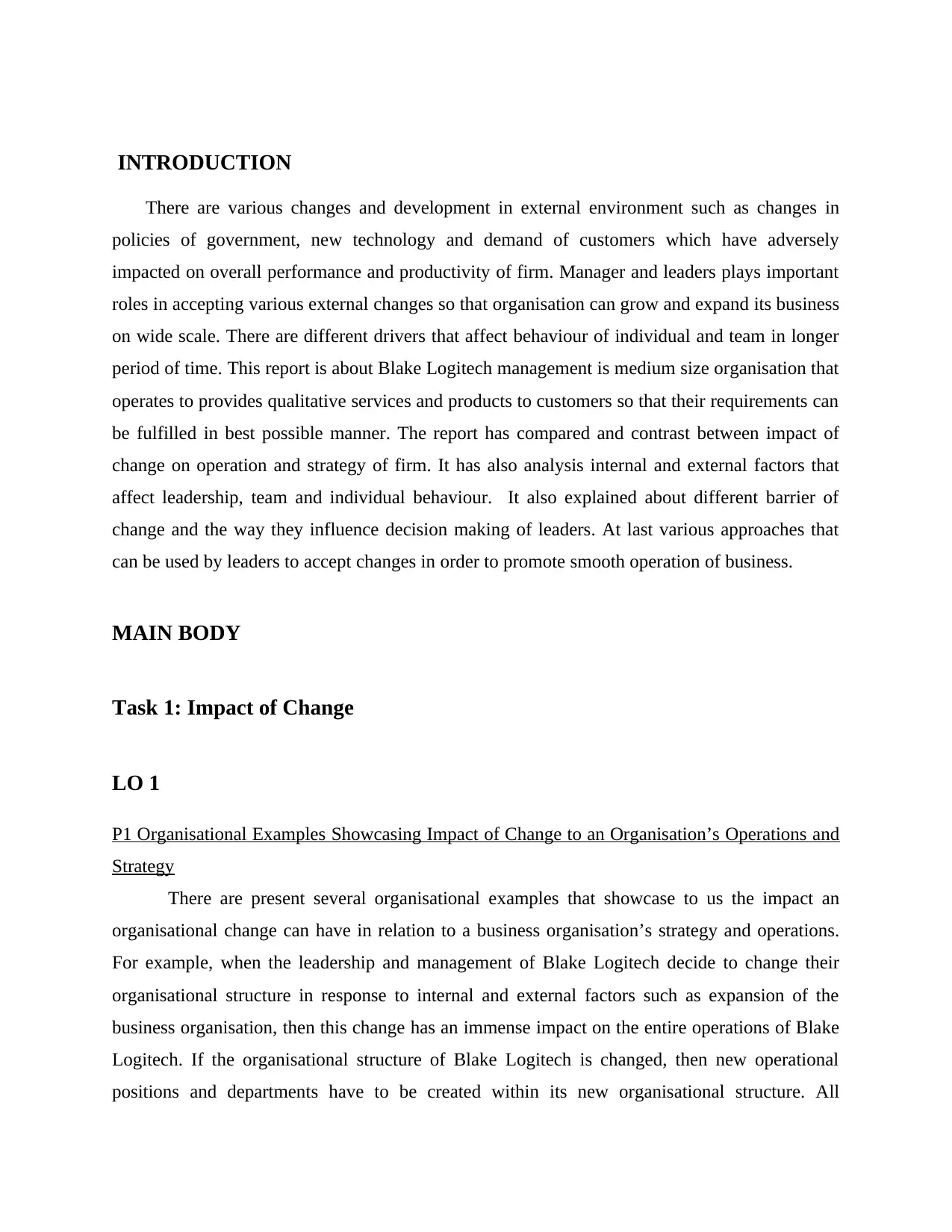
INTRODUCTION
There are various changes and development in external environment such as changes in
policies of government, new technology and demand of customers which have adversely
impacted on overall performance and productivity of firm. Manager and leaders plays important
roles in accepting various external changes so that organisation can grow and expand its business
on wide scale. There are different drivers that affect behaviour of individual and team in longer
period of time. This report is about Blake Logitech management is medium size organisation that
operates to provides qualitative services and products to customers so that their requirements can
be fulfilled in best possible manner. The report has compared and contrast between impact of
change on operation and strategy of firm. It has also analysis internal and external factors that
affect leadership, team and individual behaviour. It also explained about different barrier of
change and the way they influence decision making of leaders. At last various approaches that
can be used by leaders to accept changes in order to promote smooth operation of business.
MAIN BODY
Task 1: Impact of Change
LO 1
P1 Organisational Examples Showcasing Impact of Change to an Organisation’s Operations and
Strategy
There are present several organisational examples that showcase to us the impact an
organisational change can have in relation to a business organisation’s strategy and operations.
For example, when the leadership and management of Blake Logitech decide to change their
organisational structure in response to internal and external factors such as expansion of the
business organisation, then this change has an immense impact on the entire operations of Blake
Logitech. If the organisational structure of Blake Logitech is changed, then new operational
positions and departments have to be created within its new organisational structure. All
There are various changes and development in external environment such as changes in
policies of government, new technology and demand of customers which have adversely
impacted on overall performance and productivity of firm. Manager and leaders plays important
roles in accepting various external changes so that organisation can grow and expand its business
on wide scale. There are different drivers that affect behaviour of individual and team in longer
period of time. This report is about Blake Logitech management is medium size organisation that
operates to provides qualitative services and products to customers so that their requirements can
be fulfilled in best possible manner. The report has compared and contrast between impact of
change on operation and strategy of firm. It has also analysis internal and external factors that
affect leadership, team and individual behaviour. It also explained about different barrier of
change and the way they influence decision making of leaders. At last various approaches that
can be used by leaders to accept changes in order to promote smooth operation of business.
MAIN BODY
Task 1: Impact of Change
LO 1
P1 Organisational Examples Showcasing Impact of Change to an Organisation’s Operations and
Strategy
There are present several organisational examples that showcase to us the impact an
organisational change can have in relation to a business organisation’s strategy and operations.
For example, when the leadership and management of Blake Logitech decide to change their
organisational structure in response to internal and external factors such as expansion of the
business organisation, then this change has an immense impact on the entire operations of Blake
Logitech. If the organisational structure of Blake Logitech is changed, then new operational
positions and departments have to be created within its new organisational structure. All
⊘ This is a preview!⊘
Do you want full access?
Subscribe today to unlock all pages.

Trusted by 1+ million students worldwide
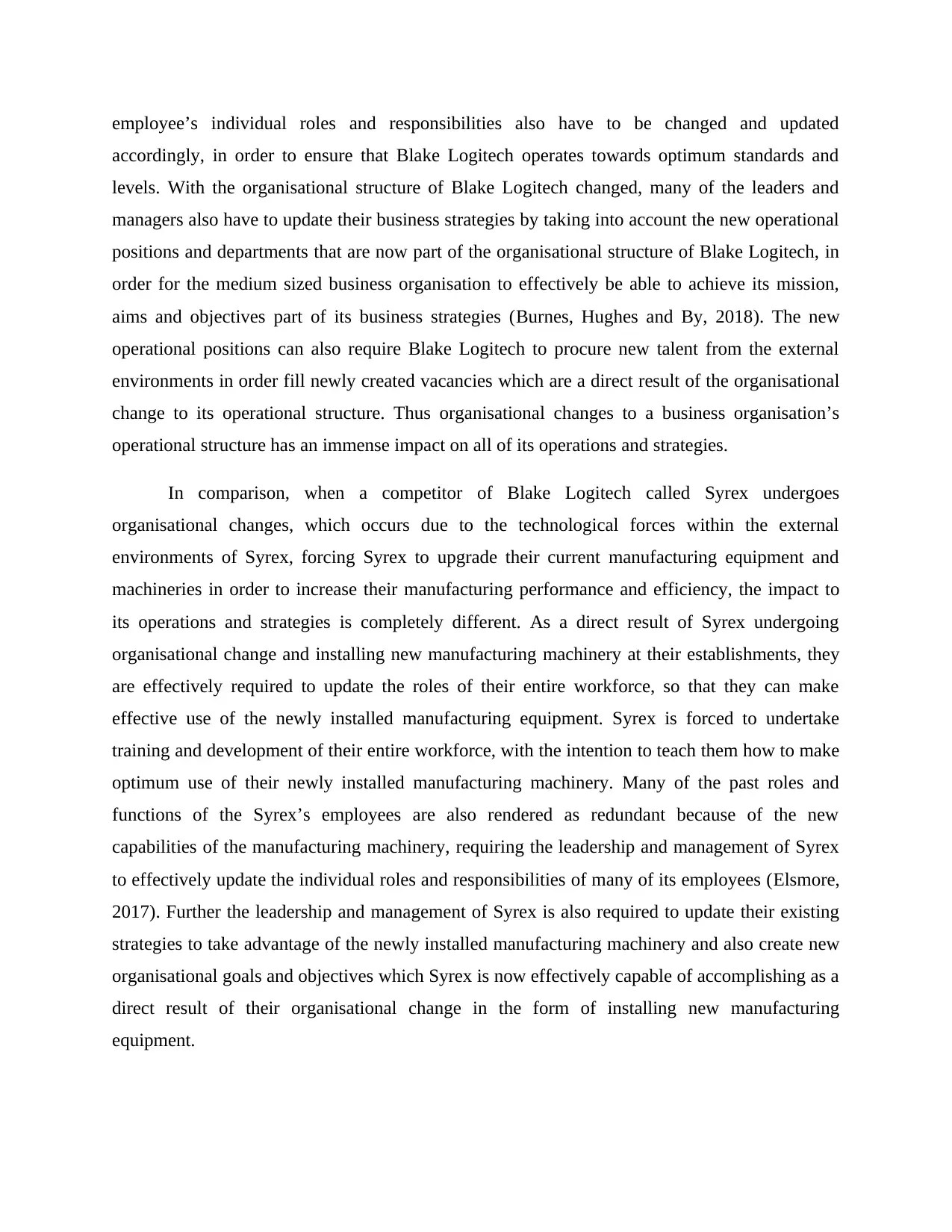
employee’s individual roles and responsibilities also have to be changed and updated
accordingly, in order to ensure that Blake Logitech operates towards optimum standards and
levels. With the organisational structure of Blake Logitech changed, many of the leaders and
managers also have to update their business strategies by taking into account the new operational
positions and departments that are now part of the organisational structure of Blake Logitech, in
order for the medium sized business organisation to effectively be able to achieve its mission,
aims and objectives part of its business strategies (Burnes, Hughes and By, 2018). The new
operational positions can also require Blake Logitech to procure new talent from the external
environments in order fill newly created vacancies which are a direct result of the organisational
change to its operational structure. Thus organisational changes to a business organisation’s
operational structure has an immense impact on all of its operations and strategies.
In comparison, when a competitor of Blake Logitech called Syrex undergoes
organisational changes, which occurs due to the technological forces within the external
environments of Syrex, forcing Syrex to upgrade their current manufacturing equipment and
machineries in order to increase their manufacturing performance and efficiency, the impact to
its operations and strategies is completely different. As a direct result of Syrex undergoing
organisational change and installing new manufacturing machinery at their establishments, they
are effectively required to update the roles of their entire workforce, so that they can make
effective use of the newly installed manufacturing equipment. Syrex is forced to undertake
training and development of their entire workforce, with the intention to teach them how to make
optimum use of their newly installed manufacturing machinery. Many of the past roles and
functions of the Syrex’s employees are also rendered as redundant because of the new
capabilities of the manufacturing machinery, requiring the leadership and management of Syrex
to effectively update the individual roles and responsibilities of many of its employees (Elsmore,
2017). Further the leadership and management of Syrex is also required to update their existing
strategies to take advantage of the newly installed manufacturing machinery and also create new
organisational goals and objectives which Syrex is now effectively capable of accomplishing as a
direct result of their organisational change in the form of installing new manufacturing
equipment.
accordingly, in order to ensure that Blake Logitech operates towards optimum standards and
levels. With the organisational structure of Blake Logitech changed, many of the leaders and
managers also have to update their business strategies by taking into account the new operational
positions and departments that are now part of the organisational structure of Blake Logitech, in
order for the medium sized business organisation to effectively be able to achieve its mission,
aims and objectives part of its business strategies (Burnes, Hughes and By, 2018). The new
operational positions can also require Blake Logitech to procure new talent from the external
environments in order fill newly created vacancies which are a direct result of the organisational
change to its operational structure. Thus organisational changes to a business organisation’s
operational structure has an immense impact on all of its operations and strategies.
In comparison, when a competitor of Blake Logitech called Syrex undergoes
organisational changes, which occurs due to the technological forces within the external
environments of Syrex, forcing Syrex to upgrade their current manufacturing equipment and
machineries in order to increase their manufacturing performance and efficiency, the impact to
its operations and strategies is completely different. As a direct result of Syrex undergoing
organisational change and installing new manufacturing machinery at their establishments, they
are effectively required to update the roles of their entire workforce, so that they can make
effective use of the newly installed manufacturing equipment. Syrex is forced to undertake
training and development of their entire workforce, with the intention to teach them how to make
optimum use of their newly installed manufacturing machinery. Many of the past roles and
functions of the Syrex’s employees are also rendered as redundant because of the new
capabilities of the manufacturing machinery, requiring the leadership and management of Syrex
to effectively update the individual roles and responsibilities of many of its employees (Elsmore,
2017). Further the leadership and management of Syrex is also required to update their existing
strategies to take advantage of the newly installed manufacturing machinery and also create new
organisational goals and objectives which Syrex is now effectively capable of accomplishing as a
direct result of their organisational change in the form of installing new manufacturing
equipment.
Paraphrase This Document
Need a fresh take? Get an instant paraphrase of this document with our AI Paraphraser
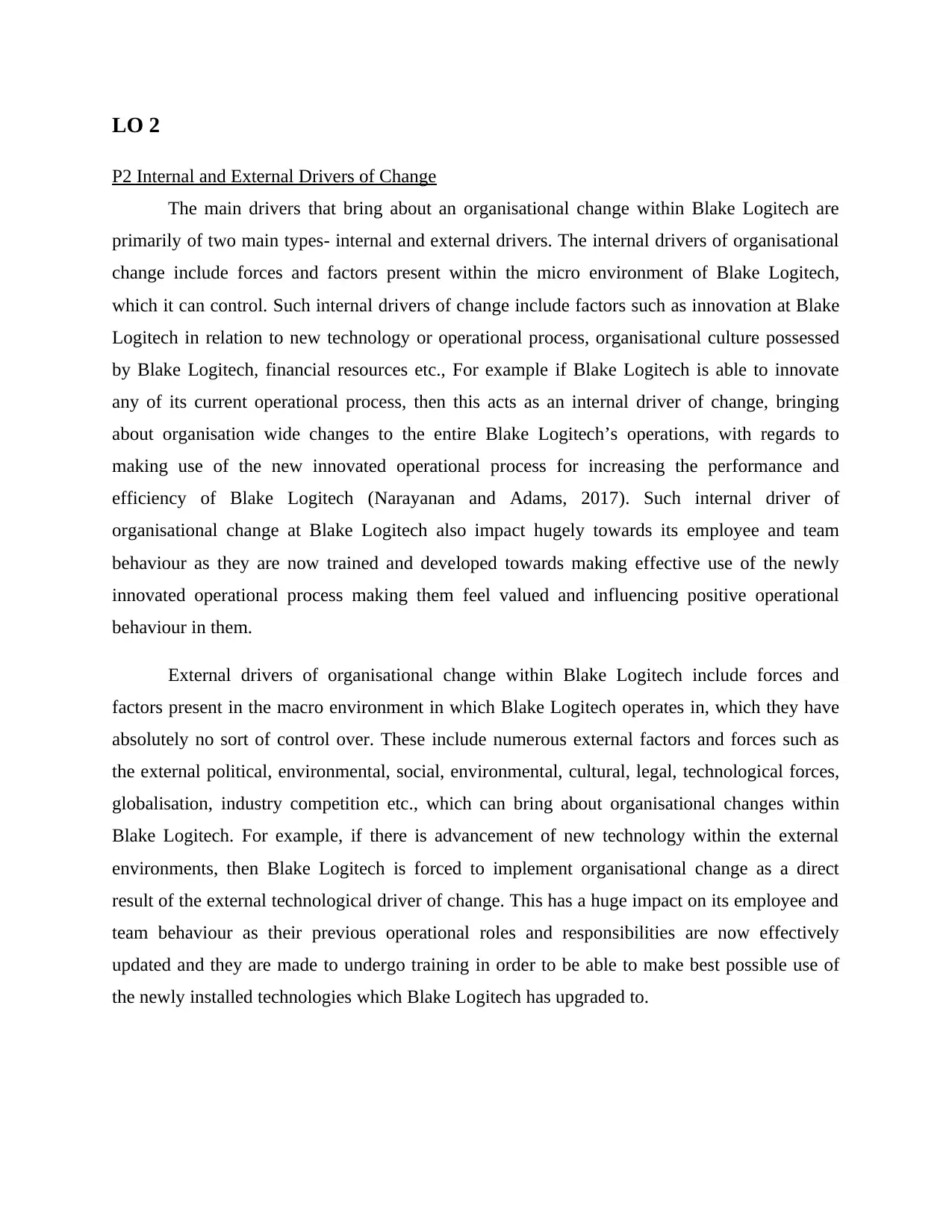
LO 2
P2 Internal and External Drivers of Change
The main drivers that bring about an organisational change within Blake Logitech are
primarily of two main types- internal and external drivers. The internal drivers of organisational
change include forces and factors present within the micro environment of Blake Logitech,
which it can control. Such internal drivers of change include factors such as innovation at Blake
Logitech in relation to new technology or operational process, organisational culture possessed
by Blake Logitech, financial resources etc., For example if Blake Logitech is able to innovate
any of its current operational process, then this acts as an internal driver of change, bringing
about organisation wide changes to the entire Blake Logitech’s operations, with regards to
making use of the new innovated operational process for increasing the performance and
efficiency of Blake Logitech (Narayanan and Adams, 2017). Such internal driver of
organisational change at Blake Logitech also impact hugely towards its employee and team
behaviour as they are now trained and developed towards making effective use of the newly
innovated operational process making them feel valued and influencing positive operational
behaviour in them.
External drivers of organisational change within Blake Logitech include forces and
factors present in the macro environment in which Blake Logitech operates in, which they have
absolutely no sort of control over. These include numerous external factors and forces such as
the external political, environmental, social, environmental, cultural, legal, technological forces,
globalisation, industry competition etc., which can bring about organisational changes within
Blake Logitech. For example, if there is advancement of new technology within the external
environments, then Blake Logitech is forced to implement organisational change as a direct
result of the external technological driver of change. This has a huge impact on its employee and
team behaviour as their previous operational roles and responsibilities are now effectively
updated and they are made to undergo training in order to be able to make best possible use of
the newly installed technologies which Blake Logitech has upgraded to.
P2 Internal and External Drivers of Change
The main drivers that bring about an organisational change within Blake Logitech are
primarily of two main types- internal and external drivers. The internal drivers of organisational
change include forces and factors present within the micro environment of Blake Logitech,
which it can control. Such internal drivers of change include factors such as innovation at Blake
Logitech in relation to new technology or operational process, organisational culture possessed
by Blake Logitech, financial resources etc., For example if Blake Logitech is able to innovate
any of its current operational process, then this acts as an internal driver of change, bringing
about organisation wide changes to the entire Blake Logitech’s operations, with regards to
making use of the new innovated operational process for increasing the performance and
efficiency of Blake Logitech (Narayanan and Adams, 2017). Such internal driver of
organisational change at Blake Logitech also impact hugely towards its employee and team
behaviour as they are now trained and developed towards making effective use of the newly
innovated operational process making them feel valued and influencing positive operational
behaviour in them.
External drivers of organisational change within Blake Logitech include forces and
factors present in the macro environment in which Blake Logitech operates in, which they have
absolutely no sort of control over. These include numerous external factors and forces such as
the external political, environmental, social, environmental, cultural, legal, technological forces,
globalisation, industry competition etc., which can bring about organisational changes within
Blake Logitech. For example, if there is advancement of new technology within the external
environments, then Blake Logitech is forced to implement organisational change as a direct
result of the external technological driver of change. This has a huge impact on its employee and
team behaviour as their previous operational roles and responsibilities are now effectively
updated and they are made to undergo training in order to be able to make best possible use of
the newly installed technologies which Blake Logitech has upgraded to.
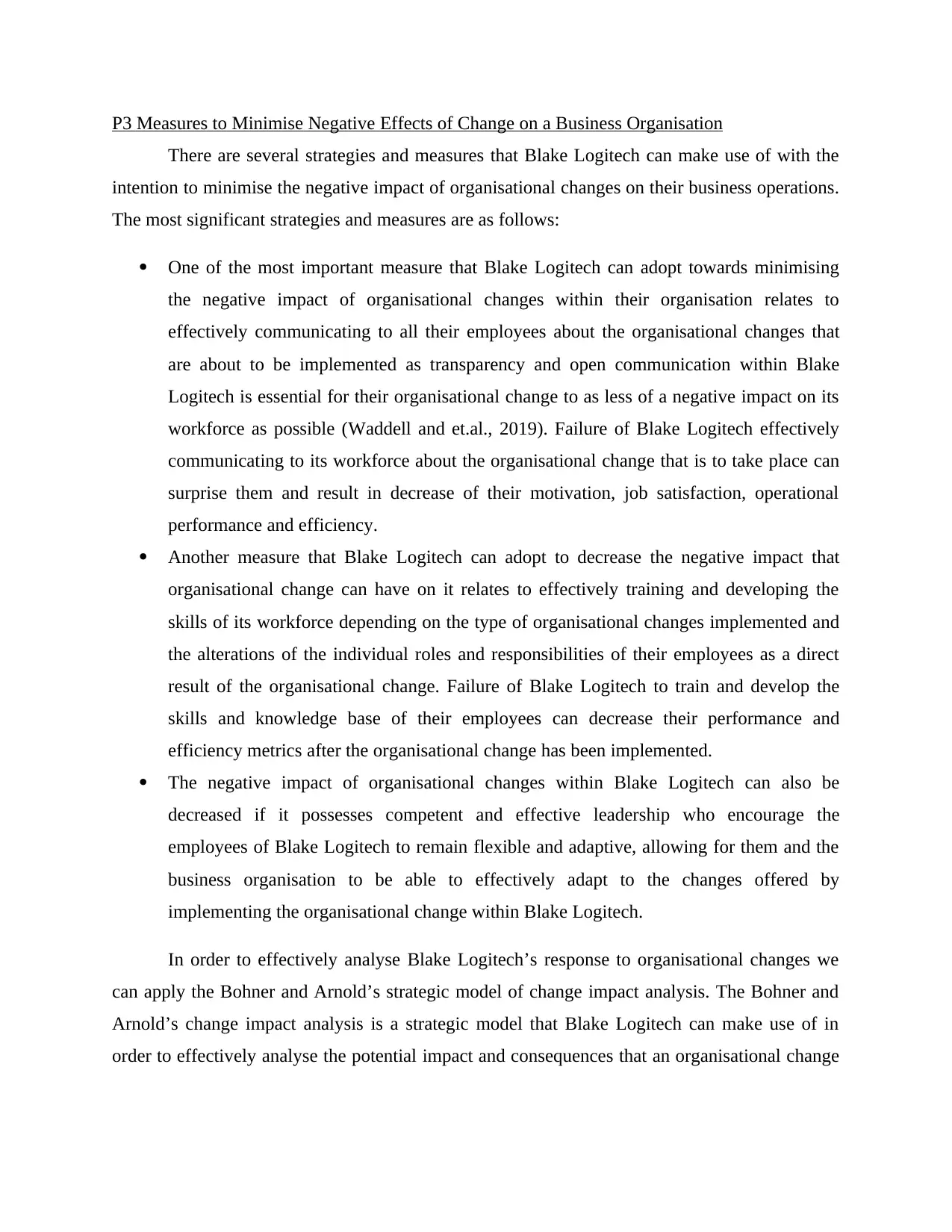
P3 Measures to Minimise Negative Effects of Change on a Business Organisation
There are several strategies and measures that Blake Logitech can make use of with the
intention to minimise the negative impact of organisational changes on their business operations.
The most significant strategies and measures are as follows:
One of the most important measure that Blake Logitech can adopt towards minimising
the negative impact of organisational changes within their organisation relates to
effectively communicating to all their employees about the organisational changes that
are about to be implemented as transparency and open communication within Blake
Logitech is essential for their organisational change to as less of a negative impact on its
workforce as possible (Waddell and et.al., 2019). Failure of Blake Logitech effectively
communicating to its workforce about the organisational change that is to take place can
surprise them and result in decrease of their motivation, job satisfaction, operational
performance and efficiency.
Another measure that Blake Logitech can adopt to decrease the negative impact that
organisational change can have on it relates to effectively training and developing the
skills of its workforce depending on the type of organisational changes implemented and
the alterations of the individual roles and responsibilities of their employees as a direct
result of the organisational change. Failure of Blake Logitech to train and develop the
skills and knowledge base of their employees can decrease their performance and
efficiency metrics after the organisational change has been implemented.
The negative impact of organisational changes within Blake Logitech can also be
decreased if it possesses competent and effective leadership who encourage the
employees of Blake Logitech to remain flexible and adaptive, allowing for them and the
business organisation to be able to effectively adapt to the changes offered by
implementing the organisational change within Blake Logitech.
In order to effectively analyse Blake Logitech’s response to organisational changes we
can apply the Bohner and Arnold’s strategic model of change impact analysis. The Bohner and
Arnold’s change impact analysis is a strategic model that Blake Logitech can make use of in
order to effectively analyse the potential impact and consequences that an organisational change
There are several strategies and measures that Blake Logitech can make use of with the
intention to minimise the negative impact of organisational changes on their business operations.
The most significant strategies and measures are as follows:
One of the most important measure that Blake Logitech can adopt towards minimising
the negative impact of organisational changes within their organisation relates to
effectively communicating to all their employees about the organisational changes that
are about to be implemented as transparency and open communication within Blake
Logitech is essential for their organisational change to as less of a negative impact on its
workforce as possible (Waddell and et.al., 2019). Failure of Blake Logitech effectively
communicating to its workforce about the organisational change that is to take place can
surprise them and result in decrease of their motivation, job satisfaction, operational
performance and efficiency.
Another measure that Blake Logitech can adopt to decrease the negative impact that
organisational change can have on it relates to effectively training and developing the
skills of its workforce depending on the type of organisational changes implemented and
the alterations of the individual roles and responsibilities of their employees as a direct
result of the organisational change. Failure of Blake Logitech to train and develop the
skills and knowledge base of their employees can decrease their performance and
efficiency metrics after the organisational change has been implemented.
The negative impact of organisational changes within Blake Logitech can also be
decreased if it possesses competent and effective leadership who encourage the
employees of Blake Logitech to remain flexible and adaptive, allowing for them and the
business organisation to be able to effectively adapt to the changes offered by
implementing the organisational change within Blake Logitech.
In order to effectively analyse Blake Logitech’s response to organisational changes we
can apply the Bohner and Arnold’s strategic model of change impact analysis. The Bohner and
Arnold’s change impact analysis is a strategic model that Blake Logitech can make use of in
order to effectively analyse the potential impact and consequences that an organisational change
⊘ This is a preview!⊘
Do you want full access?
Subscribe today to unlock all pages.

Trusted by 1+ million students worldwide
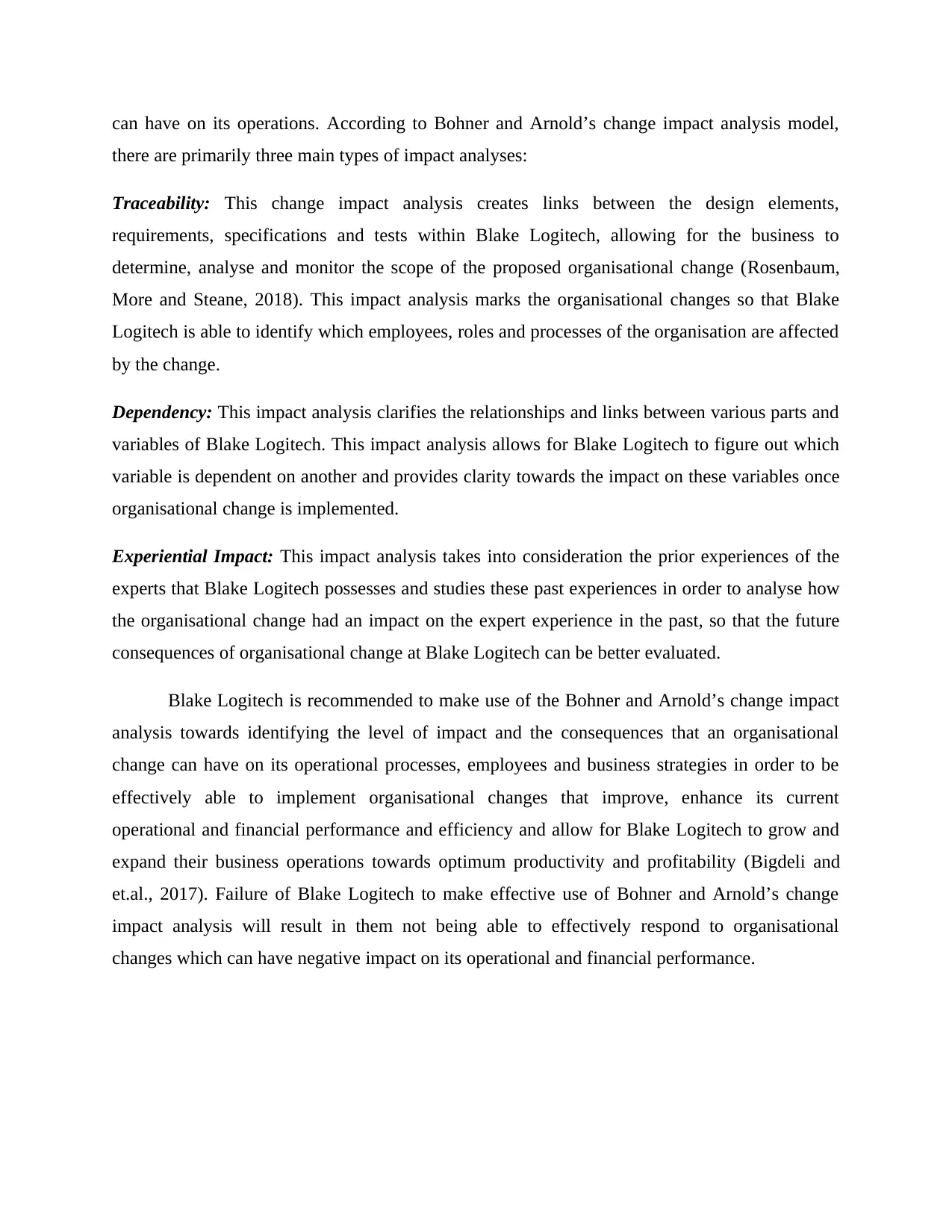
can have on its operations. According to Bohner and Arnold’s change impact analysis model,
there are primarily three main types of impact analyses:
Traceability: This change impact analysis creates links between the design elements,
requirements, specifications and tests within Blake Logitech, allowing for the business to
determine, analyse and monitor the scope of the proposed organisational change (Rosenbaum,
More and Steane, 2018). This impact analysis marks the organisational changes so that Blake
Logitech is able to identify which employees, roles and processes of the organisation are affected
by the change.
Dependency: This impact analysis clarifies the relationships and links between various parts and
variables of Blake Logitech. This impact analysis allows for Blake Logitech to figure out which
variable is dependent on another and provides clarity towards the impact on these variables once
organisational change is implemented.
Experiential Impact: This impact analysis takes into consideration the prior experiences of the
experts that Blake Logitech possesses and studies these past experiences in order to analyse how
the organisational change had an impact on the expert experience in the past, so that the future
consequences of organisational change at Blake Logitech can be better evaluated.
Blake Logitech is recommended to make use of the Bohner and Arnold’s change impact
analysis towards identifying the level of impact and the consequences that an organisational
change can have on its operational processes, employees and business strategies in order to be
effectively able to implement organisational changes that improve, enhance its current
operational and financial performance and efficiency and allow for Blake Logitech to grow and
expand their business operations towards optimum productivity and profitability (Bigdeli and
et.al., 2017). Failure of Blake Logitech to make effective use of Bohner and Arnold’s change
impact analysis will result in them not being able to effectively respond to organisational
changes which can have negative impact on its operational and financial performance.
there are primarily three main types of impact analyses:
Traceability: This change impact analysis creates links between the design elements,
requirements, specifications and tests within Blake Logitech, allowing for the business to
determine, analyse and monitor the scope of the proposed organisational change (Rosenbaum,
More and Steane, 2018). This impact analysis marks the organisational changes so that Blake
Logitech is able to identify which employees, roles and processes of the organisation are affected
by the change.
Dependency: This impact analysis clarifies the relationships and links between various parts and
variables of Blake Logitech. This impact analysis allows for Blake Logitech to figure out which
variable is dependent on another and provides clarity towards the impact on these variables once
organisational change is implemented.
Experiential Impact: This impact analysis takes into consideration the prior experiences of the
experts that Blake Logitech possesses and studies these past experiences in order to analyse how
the organisational change had an impact on the expert experience in the past, so that the future
consequences of organisational change at Blake Logitech can be better evaluated.
Blake Logitech is recommended to make use of the Bohner and Arnold’s change impact
analysis towards identifying the level of impact and the consequences that an organisational
change can have on its operational processes, employees and business strategies in order to be
effectively able to implement organisational changes that improve, enhance its current
operational and financial performance and efficiency and allow for Blake Logitech to grow and
expand their business operations towards optimum productivity and profitability (Bigdeli and
et.al., 2017). Failure of Blake Logitech to make effective use of Bohner and Arnold’s change
impact analysis will result in them not being able to effectively respond to organisational
changes which can have negative impact on its operational and financial performance.
Paraphrase This Document
Need a fresh take? Get an instant paraphrase of this document with our AI Paraphraser
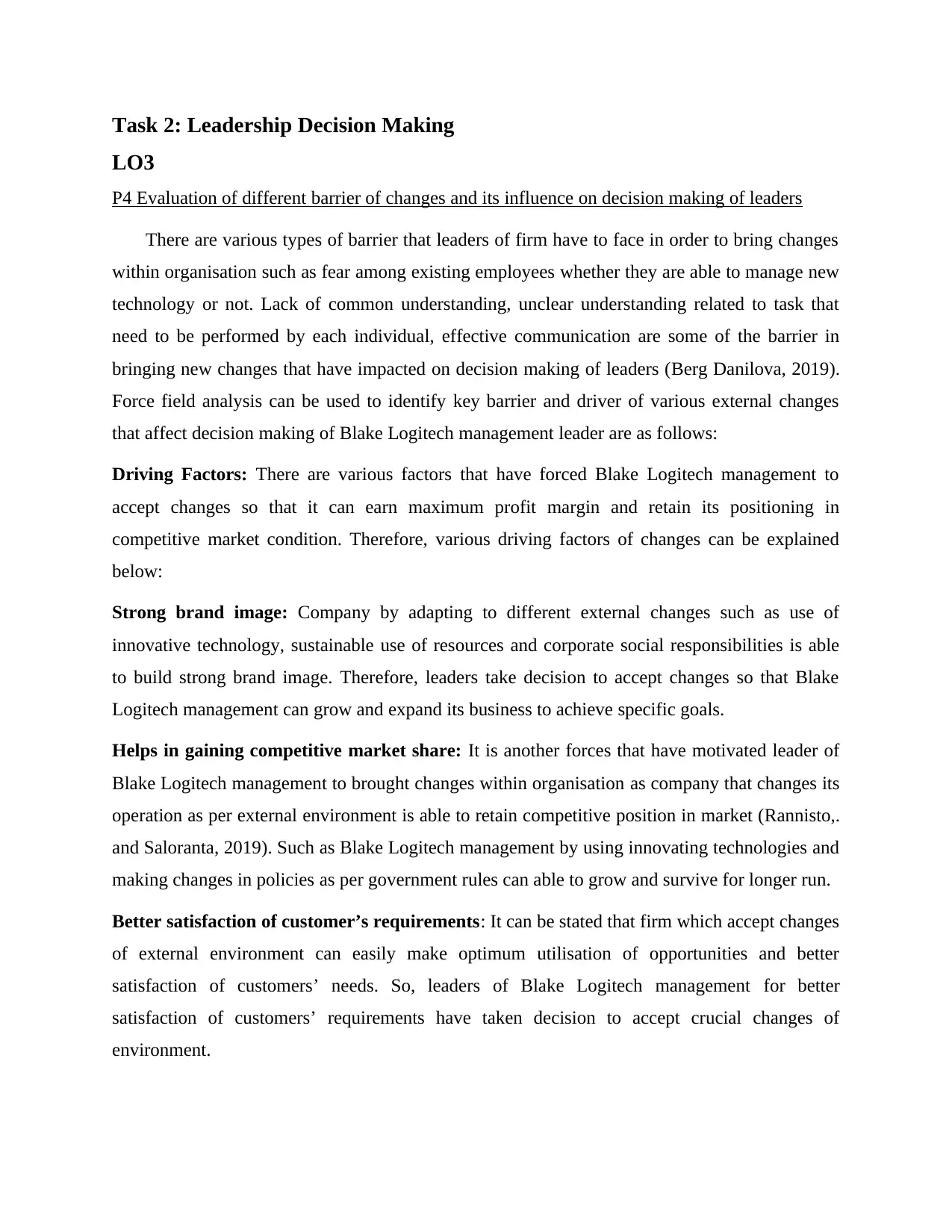
Task 2: Leadership Decision Making
LO3
P4 Evaluation of different barrier of changes and its influence on decision making of leaders
There are various types of barrier that leaders of firm have to face in order to bring changes
within organisation such as fear among existing employees whether they are able to manage new
technology or not. Lack of common understanding, unclear understanding related to task that
need to be performed by each individual, effective communication are some of the barrier in
bringing new changes that have impacted on decision making of leaders (Berg Danilova, 2019).
Force field analysis can be used to identify key barrier and driver of various external changes
that affect decision making of Blake Logitech management leader are as follows:
Driving Factors: There are various factors that have forced Blake Logitech management to
accept changes so that it can earn maximum profit margin and retain its positioning in
competitive market condition. Therefore, various driving factors of changes can be explained
below:
Strong brand image: Company by adapting to different external changes such as use of
innovative technology, sustainable use of resources and corporate social responsibilities is able
to build strong brand image. Therefore, leaders take decision to accept changes so that Blake
Logitech management can grow and expand its business to achieve specific goals.
Helps in gaining competitive market share: It is another forces that have motivated leader of
Blake Logitech management to brought changes within organisation as company that changes its
operation as per external environment is able to retain competitive position in market (Rannisto,.
and Saloranta, 2019). Such as Blake Logitech management by using innovating technologies and
making changes in policies as per government rules can able to grow and survive for longer run.
Better satisfaction of customer’s requirements: It can be stated that firm which accept changes
of external environment can easily make optimum utilisation of opportunities and better
satisfaction of customers’ needs. So, leaders of Blake Logitech management for better
satisfaction of customers’ requirements have taken decision to accept crucial changes of
environment.
LO3
P4 Evaluation of different barrier of changes and its influence on decision making of leaders
There are various types of barrier that leaders of firm have to face in order to bring changes
within organisation such as fear among existing employees whether they are able to manage new
technology or not. Lack of common understanding, unclear understanding related to task that
need to be performed by each individual, effective communication are some of the barrier in
bringing new changes that have impacted on decision making of leaders (Berg Danilova, 2019).
Force field analysis can be used to identify key barrier and driver of various external changes
that affect decision making of Blake Logitech management leader are as follows:
Driving Factors: There are various factors that have forced Blake Logitech management to
accept changes so that it can earn maximum profit margin and retain its positioning in
competitive market condition. Therefore, various driving factors of changes can be explained
below:
Strong brand image: Company by adapting to different external changes such as use of
innovative technology, sustainable use of resources and corporate social responsibilities is able
to build strong brand image. Therefore, leaders take decision to accept changes so that Blake
Logitech management can grow and expand its business to achieve specific goals.
Helps in gaining competitive market share: It is another forces that have motivated leader of
Blake Logitech management to brought changes within organisation as company that changes its
operation as per external environment is able to retain competitive position in market (Rannisto,.
and Saloranta, 2019). Such as Blake Logitech management by using innovating technologies and
making changes in policies as per government rules can able to grow and survive for longer run.
Better satisfaction of customer’s requirements: It can be stated that firm which accept changes
of external environment can easily make optimum utilisation of opportunities and better
satisfaction of customers’ needs. So, leaders of Blake Logitech management for better
satisfaction of customers’ requirements have taken decision to accept crucial changes of
environment.
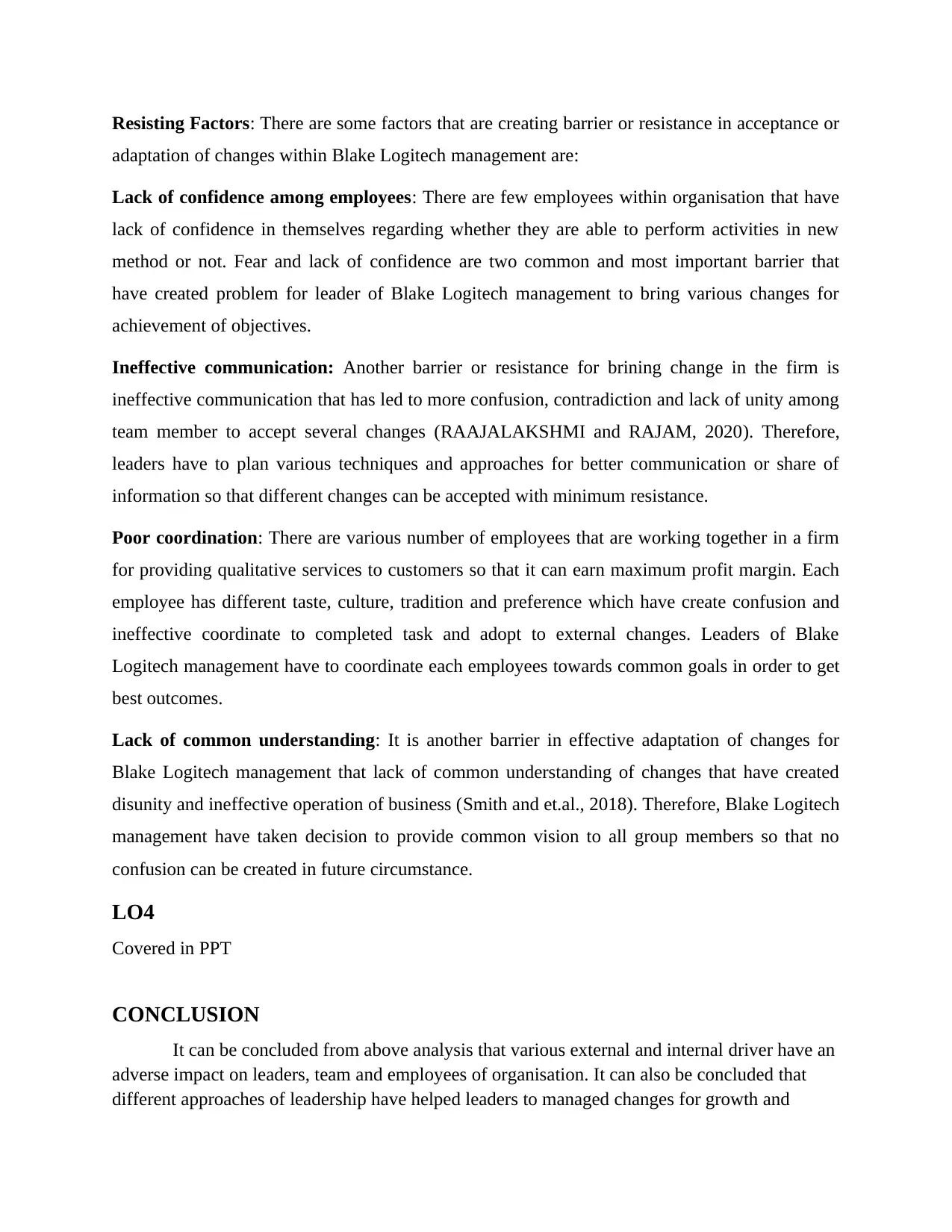
Resisting Factors: There are some factors that are creating barrier or resistance in acceptance or
adaptation of changes within Blake Logitech management are:
Lack of confidence among employees: There are few employees within organisation that have
lack of confidence in themselves regarding whether they are able to perform activities in new
method or not. Fear and lack of confidence are two common and most important barrier that
have created problem for leader of Blake Logitech management to bring various changes for
achievement of objectives.
Ineffective communication: Another barrier or resistance for brining change in the firm is
ineffective communication that has led to more confusion, contradiction and lack of unity among
team member to accept several changes (RAAJALAKSHMI and RAJAM, 2020). Therefore,
leaders have to plan various techniques and approaches for better communication or share of
information so that different changes can be accepted with minimum resistance.
Poor coordination: There are various number of employees that are working together in a firm
for providing qualitative services to customers so that it can earn maximum profit margin. Each
employee has different taste, culture, tradition and preference which have create confusion and
ineffective coordinate to completed task and adopt to external changes. Leaders of Blake
Logitech management have to coordinate each employees towards common goals in order to get
best outcomes.
Lack of common understanding: It is another barrier in effective adaptation of changes for
Blake Logitech management that lack of common understanding of changes that have created
disunity and ineffective operation of business (Smith and et.al., 2018). Therefore, Blake Logitech
management have taken decision to provide common vision to all group members so that no
confusion can be created in future circumstance.
LO4
Covered in PPT
CONCLUSION
It can be concluded from above analysis that various external and internal driver have an
adverse impact on leaders, team and employees of organisation. It can also be concluded that
different approaches of leadership have helped leaders to managed changes for growth and
adaptation of changes within Blake Logitech management are:
Lack of confidence among employees: There are few employees within organisation that have
lack of confidence in themselves regarding whether they are able to perform activities in new
method or not. Fear and lack of confidence are two common and most important barrier that
have created problem for leader of Blake Logitech management to bring various changes for
achievement of objectives.
Ineffective communication: Another barrier or resistance for brining change in the firm is
ineffective communication that has led to more confusion, contradiction and lack of unity among
team member to accept several changes (RAAJALAKSHMI and RAJAM, 2020). Therefore,
leaders have to plan various techniques and approaches for better communication or share of
information so that different changes can be accepted with minimum resistance.
Poor coordination: There are various number of employees that are working together in a firm
for providing qualitative services to customers so that it can earn maximum profit margin. Each
employee has different taste, culture, tradition and preference which have create confusion and
ineffective coordinate to completed task and adopt to external changes. Leaders of Blake
Logitech management have to coordinate each employees towards common goals in order to get
best outcomes.
Lack of common understanding: It is another barrier in effective adaptation of changes for
Blake Logitech management that lack of common understanding of changes that have created
disunity and ineffective operation of business (Smith and et.al., 2018). Therefore, Blake Logitech
management have taken decision to provide common vision to all group members so that no
confusion can be created in future circumstance.
LO4
Covered in PPT
CONCLUSION
It can be concluded from above analysis that various external and internal driver have an
adverse impact on leaders, team and employees of organisation. It can also be concluded that
different approaches of leadership have helped leaders to managed changes for growth and
⊘ This is a preview!⊘
Do you want full access?
Subscribe today to unlock all pages.

Trusted by 1+ million students worldwide

success of enterprise. At last it can be concluded that there are various measure that have been
taken by leader to minimise negative impacts for smooth operation of business.
taken by leader to minimise negative impacts for smooth operation of business.
Paraphrase This Document
Need a fresh take? Get an instant paraphrase of this document with our AI Paraphraser
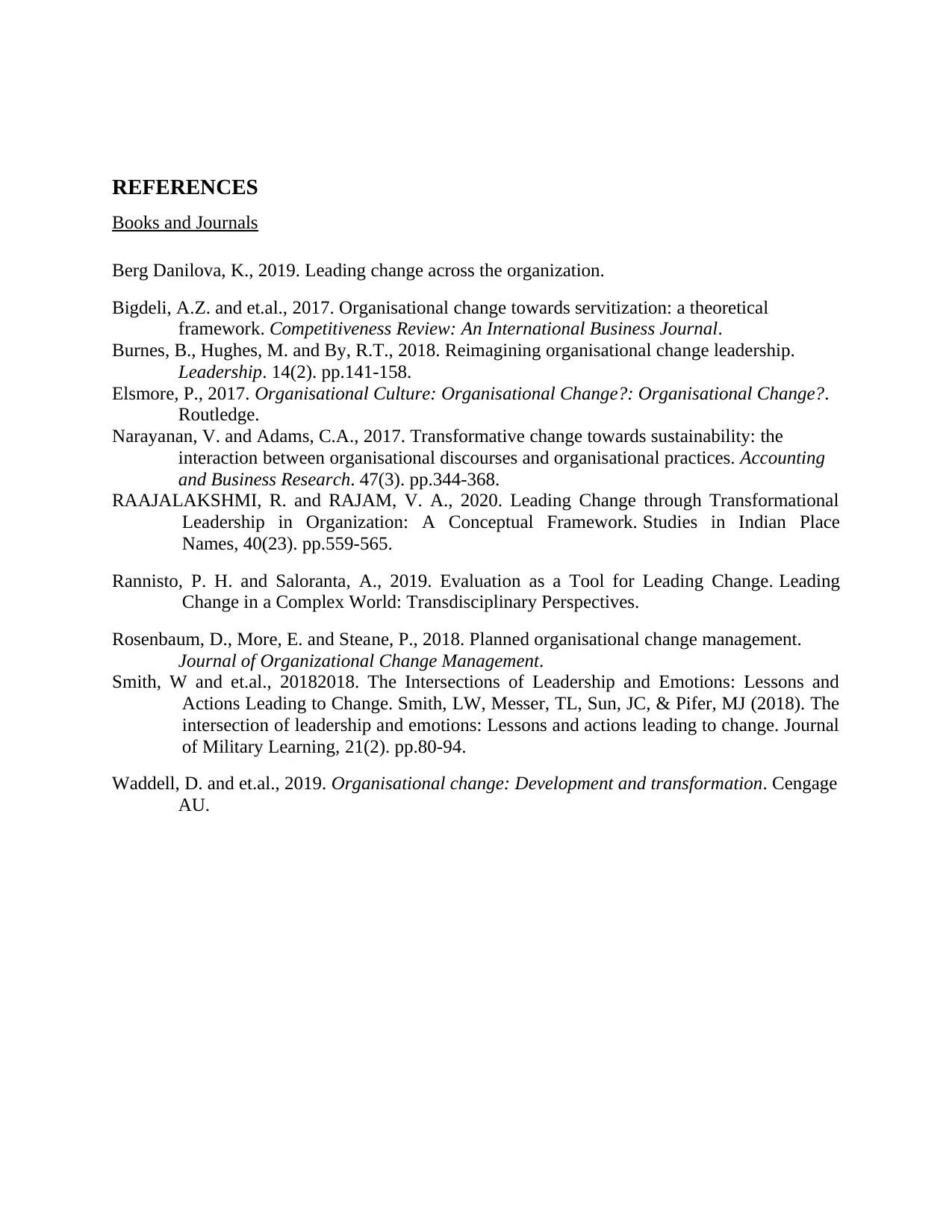
REFERENCES
Books and Journals
Berg Danilova, K., 2019. Leading change across the organization.
Bigdeli, A.Z. and et.al., 2017. Organisational change towards servitization: a theoretical
framework. Competitiveness Review: An International Business Journal.
Burnes, B., Hughes, M. and By, R.T., 2018. Reimagining organisational change leadership.
Leadership. 14(2). pp.141-158.
Elsmore, P., 2017. Organisational Culture: Organisational Change?: Organisational Change?.
Routledge.
Narayanan, V. and Adams, C.A., 2017. Transformative change towards sustainability: the
interaction between organisational discourses and organisational practices. Accounting
and Business Research. 47(3). pp.344-368.
RAAJALAKSHMI, R. and RAJAM, V. A., 2020. Leading Change through Transformational
Leadership in Organization: A Conceptual Framework. Studies in Indian Place
Names, 40(23). pp.559-565.
Rannisto, P. H. and Saloranta, A., 2019. Evaluation as a Tool for Leading Change. Leading
Change in a Complex World: Transdisciplinary Perspectives.
Rosenbaum, D., More, E. and Steane, P., 2018. Planned organisational change management.
Journal of Organizational Change Management.
Smith, W and et.al., 20182018. The Intersections of Leadership and Emotions: Lessons and
Actions Leading to Change. Smith, LW, Messer, TL, Sun, JC, & Pifer, MJ (2018). The
intersection of leadership and emotions: Lessons and actions leading to change. Journal
of Military Learning, 21(2). pp.80-94.
Waddell, D. and et.al., 2019. Organisational change: Development and transformation. Cengage
AU.
Books and Journals
Berg Danilova, K., 2019. Leading change across the organization.
Bigdeli, A.Z. and et.al., 2017. Organisational change towards servitization: a theoretical
framework. Competitiveness Review: An International Business Journal.
Burnes, B., Hughes, M. and By, R.T., 2018. Reimagining organisational change leadership.
Leadership. 14(2). pp.141-158.
Elsmore, P., 2017. Organisational Culture: Organisational Change?: Organisational Change?.
Routledge.
Narayanan, V. and Adams, C.A., 2017. Transformative change towards sustainability: the
interaction between organisational discourses and organisational practices. Accounting
and Business Research. 47(3). pp.344-368.
RAAJALAKSHMI, R. and RAJAM, V. A., 2020. Leading Change through Transformational
Leadership in Organization: A Conceptual Framework. Studies in Indian Place
Names, 40(23). pp.559-565.
Rannisto, P. H. and Saloranta, A., 2019. Evaluation as a Tool for Leading Change. Leading
Change in a Complex World: Transdisciplinary Perspectives.
Rosenbaum, D., More, E. and Steane, P., 2018. Planned organisational change management.
Journal of Organizational Change Management.
Smith, W and et.al., 20182018. The Intersections of Leadership and Emotions: Lessons and
Actions Leading to Change. Smith, LW, Messer, TL, Sun, JC, & Pifer, MJ (2018). The
intersection of leadership and emotions: Lessons and actions leading to change. Journal
of Military Learning, 21(2). pp.80-94.
Waddell, D. and et.al., 2019. Organisational change: Development and transformation. Cengage
AU.
1 out of 11
Related Documents
Your All-in-One AI-Powered Toolkit for Academic Success.
+13062052269
info@desklib.com
Available 24*7 on WhatsApp / Email
![[object Object]](/_next/static/media/star-bottom.7253800d.svg)
Unlock your academic potential
Copyright © 2020–2025 A2Z Services. All Rights Reserved. Developed and managed by ZUCOL.




